HND Business Unit 12: Organisational Behaviour Report - Wilko
VerifiedAdded on 2022/12/27
|14
|4428
|64
Report
AI Summary
This report provides an in-depth analysis of organisational behaviour within Wilko Retail Ltd. It examines the influences of politics, power, and culture on staff, exploring various cultural models and power dynamics. The report also delves into motivational theories, including Maslow's Hierarchy of Needs, and their application within the company. Furthermore, it evaluates the impact of effective and ineffective teams on achieving goals, referencing Tuckman's model of team development. The report concludes by applying concepts and philosophies of organisational behaviour to recommend improvements for staff performance and goal attainment within Wilko Retail Ltd. The assignment is a report written by a student to be published on Desklib.
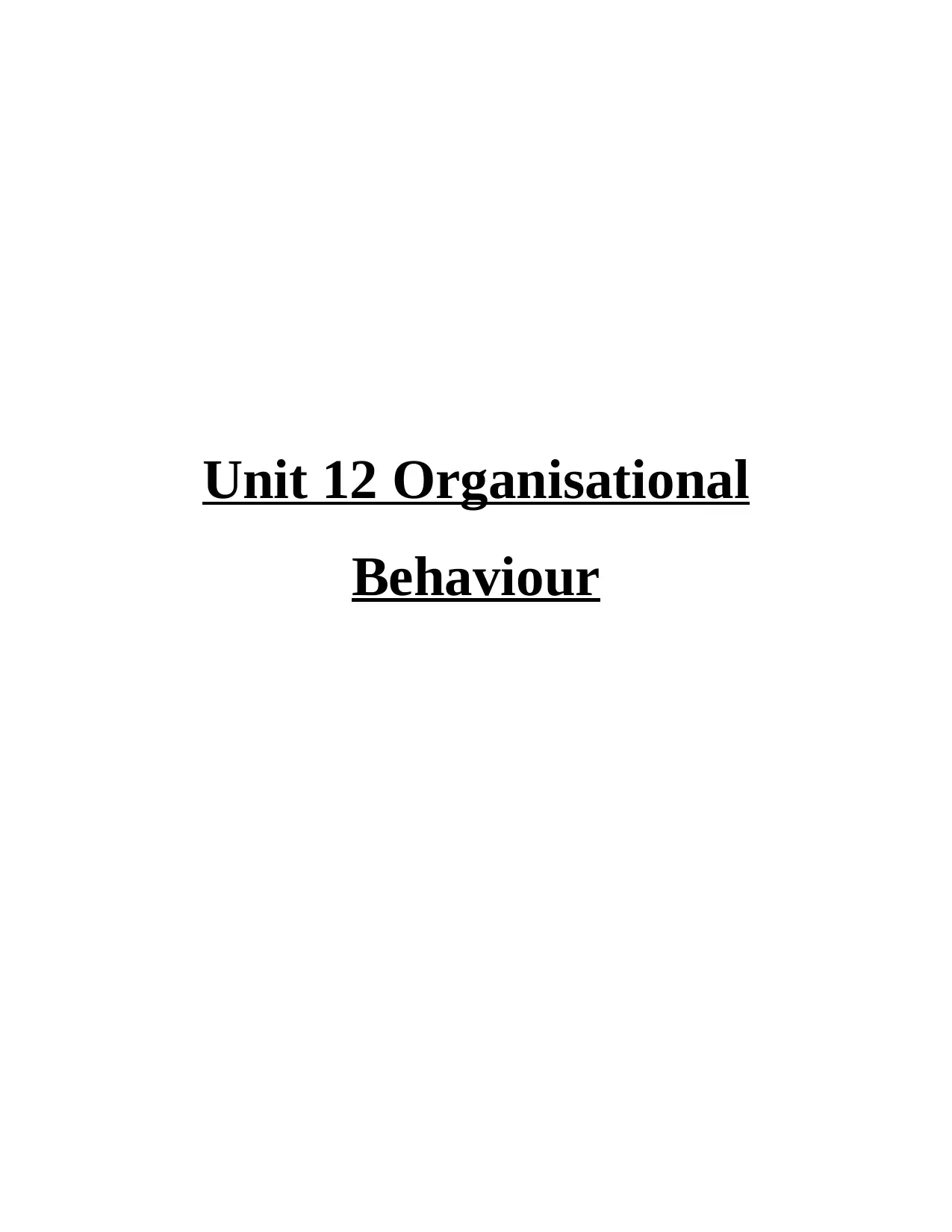
Unit 12 Organisational
Behaviour
Behaviour
Paraphrase This Document
Need a fresh take? Get an instant paraphrase of this document with our AI Paraphraser
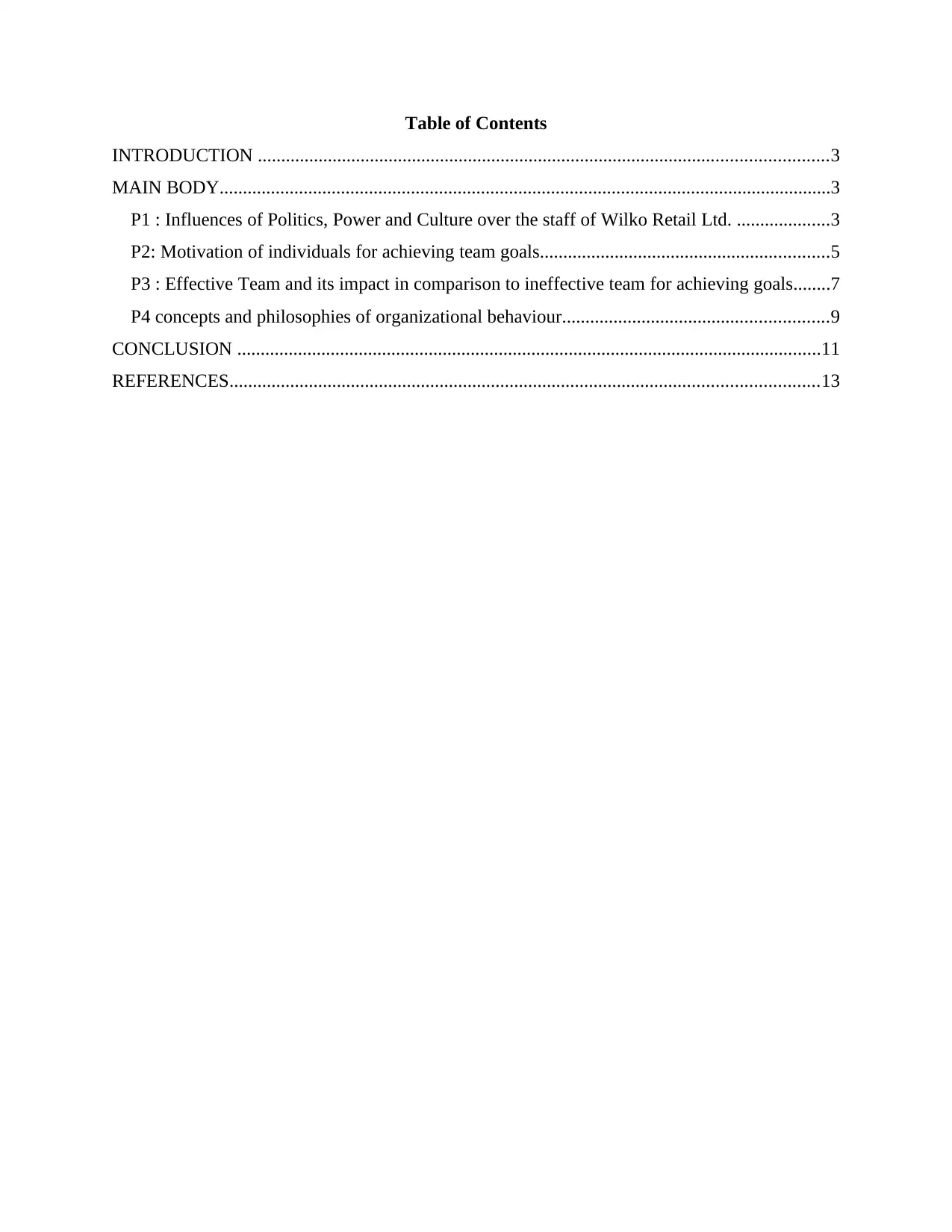
Table of Contents
INTRODUCTION ..........................................................................................................................3
MAIN BODY...................................................................................................................................3
P1 : Influences of Politics, Power and Culture over the staff of Wilko Retail Ltd. ....................3
P2: Motivation of individuals for achieving team goals..............................................................5
P3 : Effective Team and its impact in comparison to ineffective team for achieving goals........7
P4 concepts and philosophies of organizational behaviour.........................................................9
CONCLUSION .............................................................................................................................11
REFERENCES..............................................................................................................................13
INTRODUCTION ..........................................................................................................................3
MAIN BODY...................................................................................................................................3
P1 : Influences of Politics, Power and Culture over the staff of Wilko Retail Ltd. ....................3
P2: Motivation of individuals for achieving team goals..............................................................5
P3 : Effective Team and its impact in comparison to ineffective team for achieving goals........7
P4 concepts and philosophies of organizational behaviour.........................................................9
CONCLUSION .............................................................................................................................11
REFERENCES..............................................................................................................................13
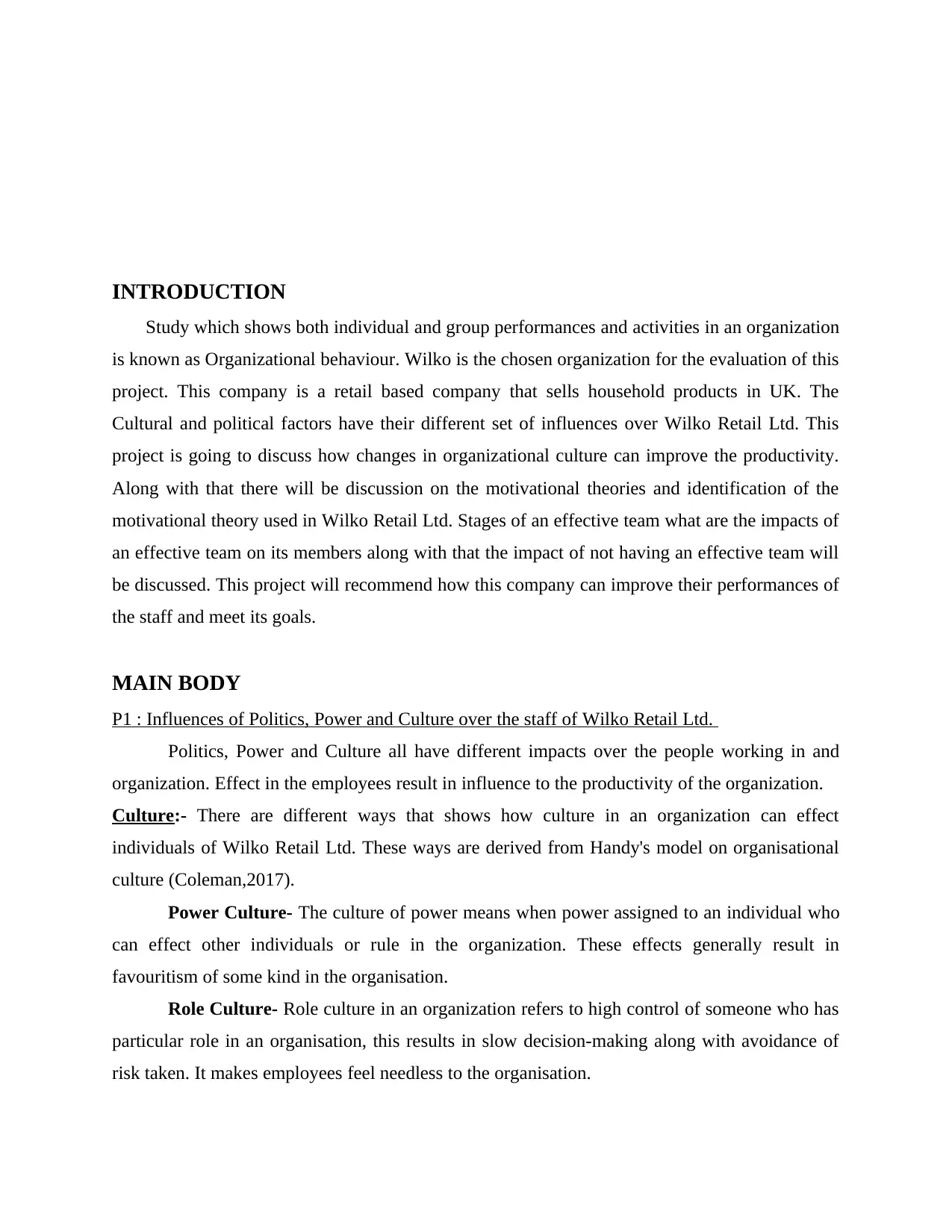
INTRODUCTION
Study which shows both individual and group performances and activities in an organization
is known as Organizational behaviour. Wilko is the chosen organization for the evaluation of this
project. This company is a retail based company that sells household products in UK. The
Cultural and political factors have their different set of influences over Wilko Retail Ltd. This
project is going to discuss how changes in organizational culture can improve the productivity.
Along with that there will be discussion on the motivational theories and identification of the
motivational theory used in Wilko Retail Ltd. Stages of an effective team what are the impacts of
an effective team on its members along with that the impact of not having an effective team will
be discussed. This project will recommend how this company can improve their performances of
the staff and meet its goals.
MAIN BODY
P1 : Influences of Politics, Power and Culture over the staff of Wilko Retail Ltd.
Politics, Power and Culture all have different impacts over the people working in and
organization. Effect in the employees result in influence to the productivity of the organization.
Culture:- There are different ways that shows how culture in an organization can effect
individuals of Wilko Retail Ltd. These ways are derived from Handy's model on organisational
culture (Coleman,2017).
Power Culture- The culture of power means when power assigned to an individual who
can effect other individuals or rule in the organization. These effects generally result in
favouritism of some kind in the organisation.
Role Culture- Role culture in an organization refers to high control of someone who has
particular role in an organisation, this results in slow decision-making along with avoidance of
risk taken. It makes employees feel needless to the organisation.
Study which shows both individual and group performances and activities in an organization
is known as Organizational behaviour. Wilko is the chosen organization for the evaluation of this
project. This company is a retail based company that sells household products in UK. The
Cultural and political factors have their different set of influences over Wilko Retail Ltd. This
project is going to discuss how changes in organizational culture can improve the productivity.
Along with that there will be discussion on the motivational theories and identification of the
motivational theory used in Wilko Retail Ltd. Stages of an effective team what are the impacts of
an effective team on its members along with that the impact of not having an effective team will
be discussed. This project will recommend how this company can improve their performances of
the staff and meet its goals.
MAIN BODY
P1 : Influences of Politics, Power and Culture over the staff of Wilko Retail Ltd.
Politics, Power and Culture all have different impacts over the people working in and
organization. Effect in the employees result in influence to the productivity of the organization.
Culture:- There are different ways that shows how culture in an organization can effect
individuals of Wilko Retail Ltd. These ways are derived from Handy's model on organisational
culture (Coleman,2017).
Power Culture- The culture of power means when power assigned to an individual who
can effect other individuals or rule in the organization. These effects generally result in
favouritism of some kind in the organisation.
Role Culture- Role culture in an organization refers to high control of someone who has
particular role in an organisation, this results in slow decision-making along with avoidance of
risk taken. It makes employees feel needless to the organisation.
⊘ This is a preview!⊘
Do you want full access?
Subscribe today to unlock all pages.

Trusted by 1+ million students worldwide
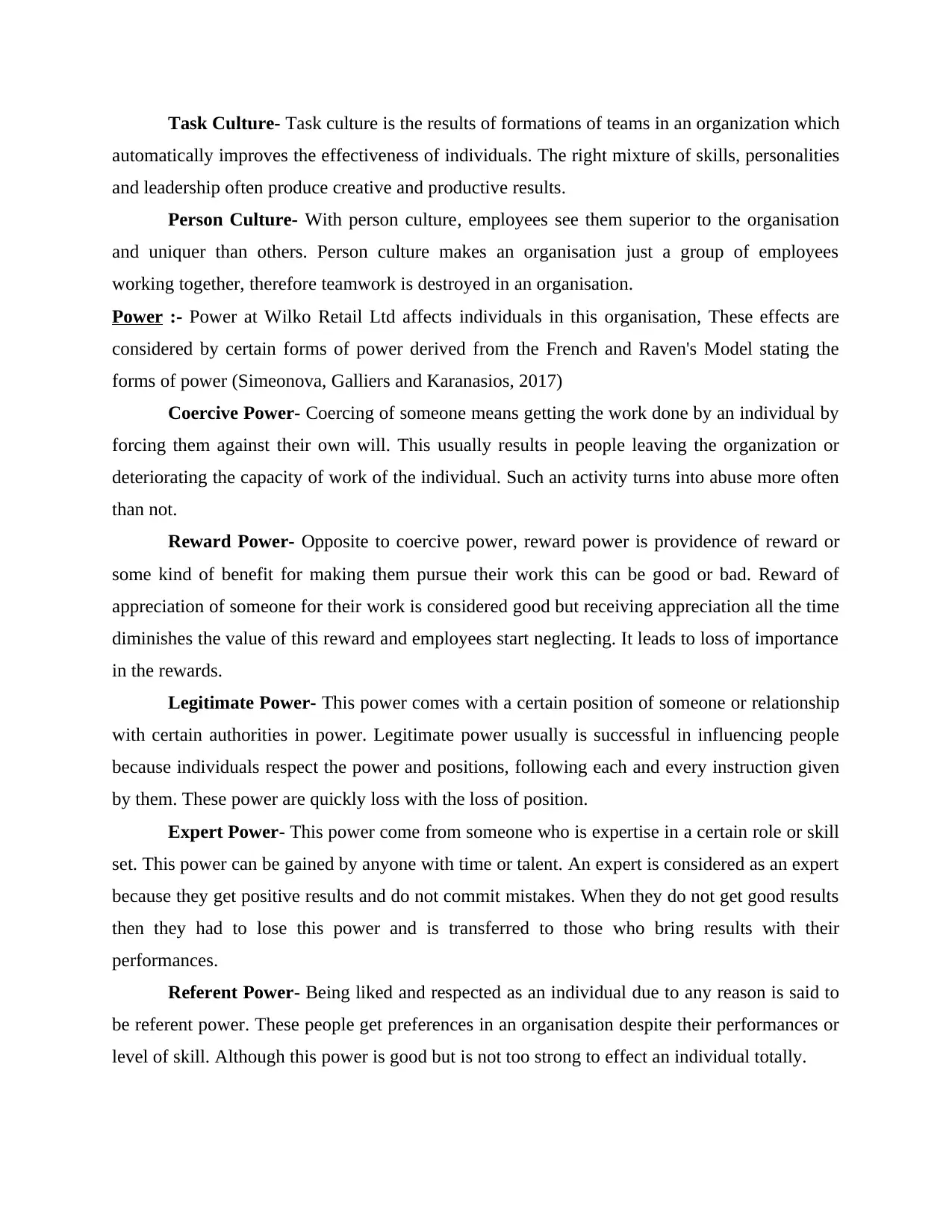
Task Culture- Task culture is the results of formations of teams in an organization which
automatically improves the effectiveness of individuals. The right mixture of skills, personalities
and leadership often produce creative and productive results.
Person Culture- With person culture, employees see them superior to the organisation
and uniquer than others. Person culture makes an organisation just a group of employees
working together, therefore teamwork is destroyed in an organisation.
Power :- Power at Wilko Retail Ltd affects individuals in this organisation, These effects are
considered by certain forms of power derived from the French and Raven's Model stating the
forms of power (Simeonova, Galliers and Karanasios, 2017)
Coercive Power- Coercing of someone means getting the work done by an individual by
forcing them against their own will. This usually results in people leaving the organization or
deteriorating the capacity of work of the individual. Such an activity turns into abuse more often
than not.
Reward Power- Opposite to coercive power, reward power is providence of reward or
some kind of benefit for making them pursue their work this can be good or bad. Reward of
appreciation of someone for their work is considered good but receiving appreciation all the time
diminishes the value of this reward and employees start neglecting. It leads to loss of importance
in the rewards.
Legitimate Power- This power comes with a certain position of someone or relationship
with certain authorities in power. Legitimate power usually is successful in influencing people
because individuals respect the power and positions, following each and every instruction given
by them. These power are quickly loss with the loss of position.
Expert Power- This power come from someone who is expertise in a certain role or skill
set. This power can be gained by anyone with time or talent. An expert is considered as an expert
because they get positive results and do not commit mistakes. When they do not get good results
then they had to lose this power and is transferred to those who bring results with their
performances.
Referent Power- Being liked and respected as an individual due to any reason is said to
be referent power. These people get preferences in an organisation despite their performances or
level of skill. Although this power is good but is not too strong to effect an individual totally.
automatically improves the effectiveness of individuals. The right mixture of skills, personalities
and leadership often produce creative and productive results.
Person Culture- With person culture, employees see them superior to the organisation
and uniquer than others. Person culture makes an organisation just a group of employees
working together, therefore teamwork is destroyed in an organisation.
Power :- Power at Wilko Retail Ltd affects individuals in this organisation, These effects are
considered by certain forms of power derived from the French and Raven's Model stating the
forms of power (Simeonova, Galliers and Karanasios, 2017)
Coercive Power- Coercing of someone means getting the work done by an individual by
forcing them against their own will. This usually results in people leaving the organization or
deteriorating the capacity of work of the individual. Such an activity turns into abuse more often
than not.
Reward Power- Opposite to coercive power, reward power is providence of reward or
some kind of benefit for making them pursue their work this can be good or bad. Reward of
appreciation of someone for their work is considered good but receiving appreciation all the time
diminishes the value of this reward and employees start neglecting. It leads to loss of importance
in the rewards.
Legitimate Power- This power comes with a certain position of someone or relationship
with certain authorities in power. Legitimate power usually is successful in influencing people
because individuals respect the power and positions, following each and every instruction given
by them. These power are quickly loss with the loss of position.
Expert Power- This power come from someone who is expertise in a certain role or skill
set. This power can be gained by anyone with time or talent. An expert is considered as an expert
because they get positive results and do not commit mistakes. When they do not get good results
then they had to lose this power and is transferred to those who bring results with their
performances.
Referent Power- Being liked and respected as an individual due to any reason is said to
be referent power. These people get preferences in an organisation despite their performances or
level of skill. Although this power is good but is not too strong to effect an individual totally.
Paraphrase This Document
Need a fresh take? Get an instant paraphrase of this document with our AI Paraphraser
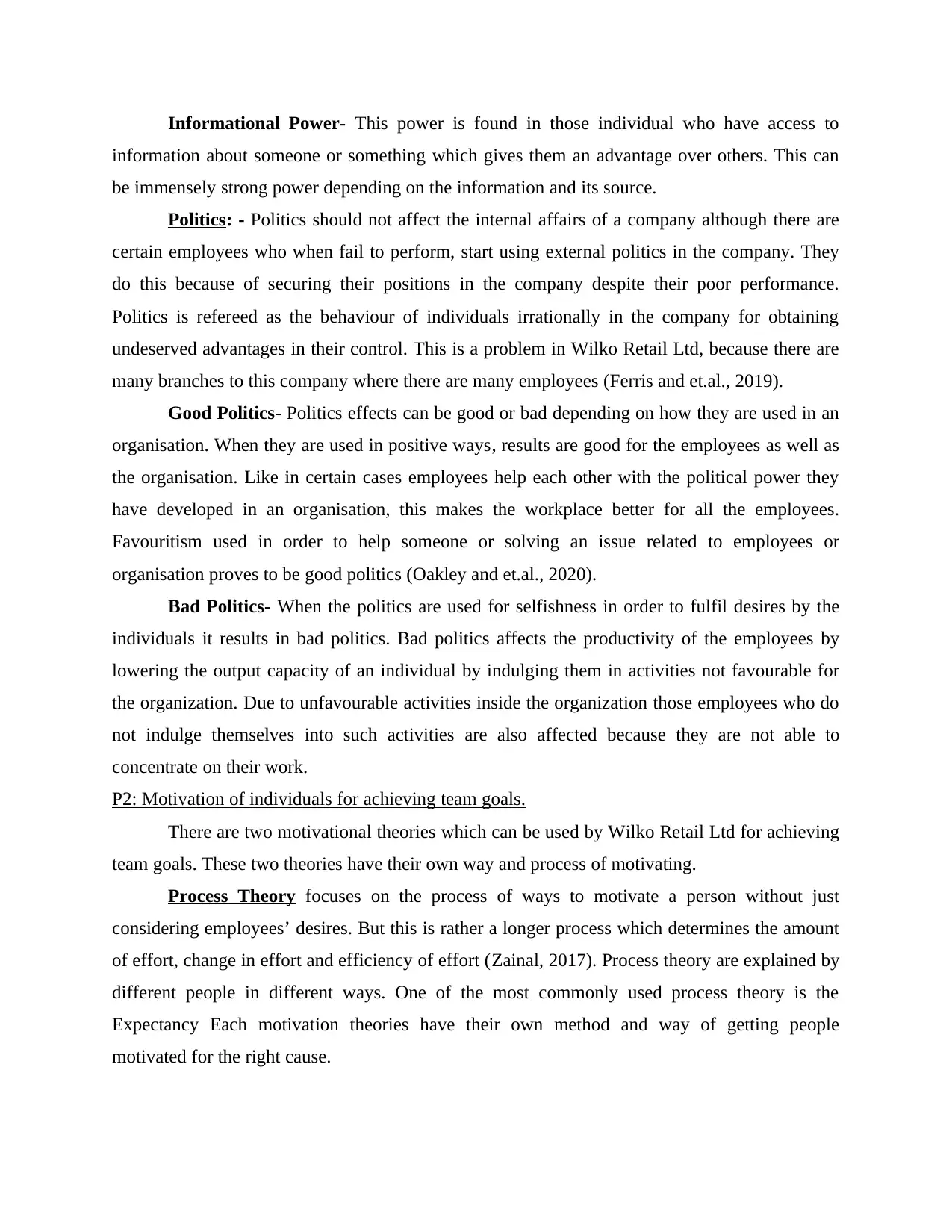
Informational Power- This power is found in those individual who have access to
information about someone or something which gives them an advantage over others. This can
be immensely strong power depending on the information and its source.
Politics: - Politics should not affect the internal affairs of a company although there are
certain employees who when fail to perform, start using external politics in the company. They
do this because of securing their positions in the company despite their poor performance.
Politics is refereed as the behaviour of individuals irrationally in the company for obtaining
undeserved advantages in their control. This is a problem in Wilko Retail Ltd, because there are
many branches to this company where there are many employees (Ferris and et.al., 2019).
Good Politics- Politics effects can be good or bad depending on how they are used in an
organisation. When they are used in positive ways, results are good for the employees as well as
the organisation. Like in certain cases employees help each other with the political power they
have developed in an organisation, this makes the workplace better for all the employees.
Favouritism used in order to help someone or solving an issue related to employees or
organisation proves to be good politics (Oakley and et.al., 2020).
Bad Politics- When the politics are used for selfishness in order to fulfil desires by the
individuals it results in bad politics. Bad politics affects the productivity of the employees by
lowering the output capacity of an individual by indulging them in activities not favourable for
the organization. Due to unfavourable activities inside the organization those employees who do
not indulge themselves into such activities are also affected because they are not able to
concentrate on their work.
P2: Motivation of individuals for achieving team goals.
There are two motivational theories which can be used by Wilko Retail Ltd for achieving
team goals. These two theories have their own way and process of motivating.
Process Theory focuses on the process of ways to motivate a person without just
considering employees’ desires. But this is rather a longer process which determines the amount
of effort, change in effort and efficiency of effort (Zainal, 2017). Process theory are explained by
different people in different ways. One of the most commonly used process theory is the
Expectancy Each motivation theories have their own method and way of getting people
motivated for the right cause.
information about someone or something which gives them an advantage over others. This can
be immensely strong power depending on the information and its source.
Politics: - Politics should not affect the internal affairs of a company although there are
certain employees who when fail to perform, start using external politics in the company. They
do this because of securing their positions in the company despite their poor performance.
Politics is refereed as the behaviour of individuals irrationally in the company for obtaining
undeserved advantages in their control. This is a problem in Wilko Retail Ltd, because there are
many branches to this company where there are many employees (Ferris and et.al., 2019).
Good Politics- Politics effects can be good or bad depending on how they are used in an
organisation. When they are used in positive ways, results are good for the employees as well as
the organisation. Like in certain cases employees help each other with the political power they
have developed in an organisation, this makes the workplace better for all the employees.
Favouritism used in order to help someone or solving an issue related to employees or
organisation proves to be good politics (Oakley and et.al., 2020).
Bad Politics- When the politics are used for selfishness in order to fulfil desires by the
individuals it results in bad politics. Bad politics affects the productivity of the employees by
lowering the output capacity of an individual by indulging them in activities not favourable for
the organization. Due to unfavourable activities inside the organization those employees who do
not indulge themselves into such activities are also affected because they are not able to
concentrate on their work.
P2: Motivation of individuals for achieving team goals.
There are two motivational theories which can be used by Wilko Retail Ltd for achieving
team goals. These two theories have their own way and process of motivating.
Process Theory focuses on the process of ways to motivate a person without just
considering employees’ desires. But this is rather a longer process which determines the amount
of effort, change in effort and efficiency of effort (Zainal, 2017). Process theory are explained by
different people in different ways. One of the most commonly used process theory is the
Expectancy Each motivation theories have their own method and way of getting people
motivated for the right cause.
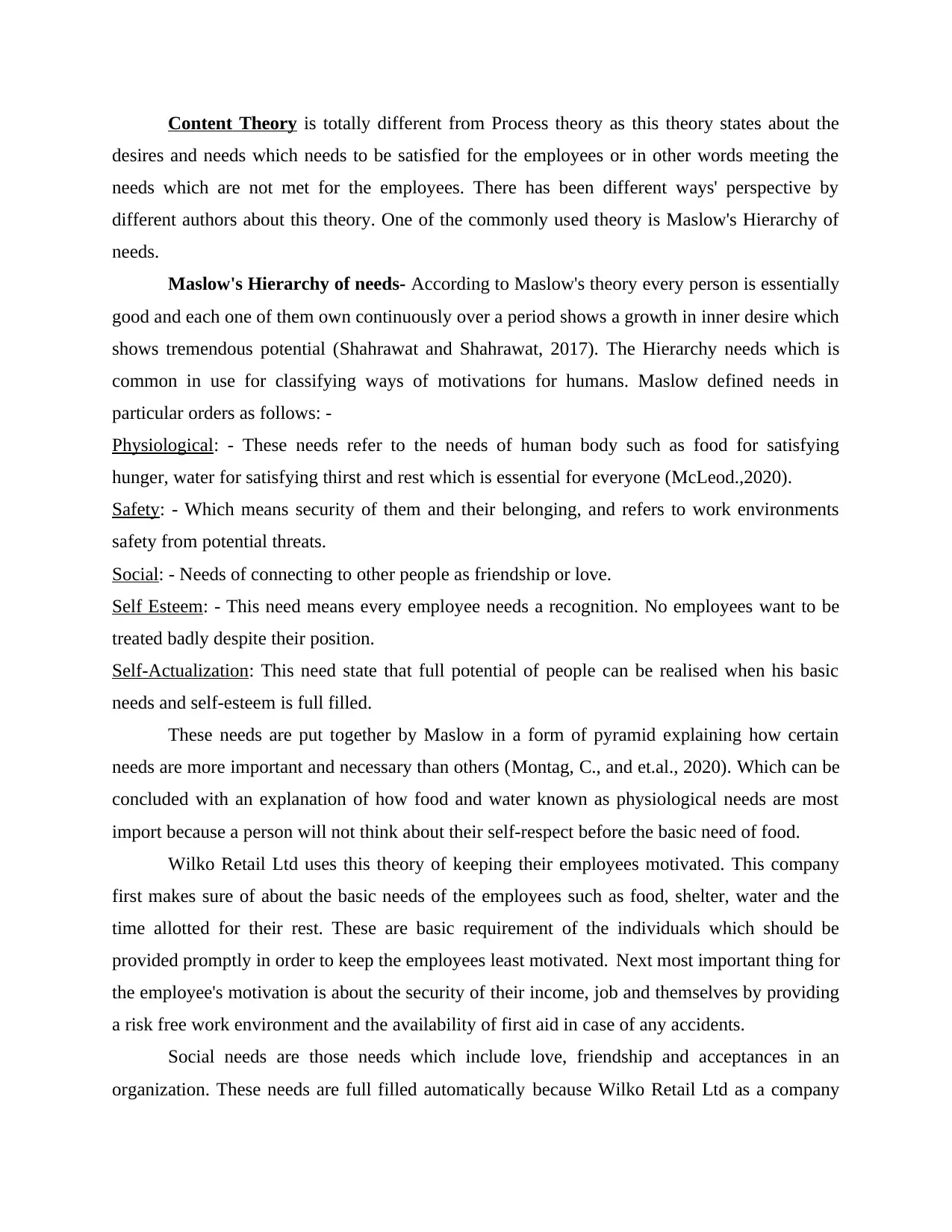
Content Theory is totally different from Process theory as this theory states about the
desires and needs which needs to be satisfied for the employees or in other words meeting the
needs which are not met for the employees. There has been different ways' perspective by
different authors about this theory. One of the commonly used theory is Maslow's Hierarchy of
needs.
Maslow's Hierarchy of needs- According to Maslow's theory every person is essentially
good and each one of them own continuously over a period shows a growth in inner desire which
shows tremendous potential (Shahrawat and Shahrawat, 2017). The Hierarchy needs which is
common in use for classifying ways of motivations for humans. Maslow defined needs in
particular orders as follows: -
Physiological: - These needs refer to the needs of human body such as food for satisfying
hunger, water for satisfying thirst and rest which is essential for everyone (McLeod.,2020).
Safety: - Which means security of them and their belonging, and refers to work environments
safety from potential threats.
Social: - Needs of connecting to other people as friendship or love.
Self Esteem: - This need means every employee needs a recognition. No employees want to be
treated badly despite their position.
Self-Actualization: This need state that full potential of people can be realised when his basic
needs and self-esteem is full filled.
These needs are put together by Maslow in a form of pyramid explaining how certain
needs are more important and necessary than others (Montag, C., and et.al., 2020). Which can be
concluded with an explanation of how food and water known as physiological needs are most
import because a person will not think about their self-respect before the basic need of food.
Wilko Retail Ltd uses this theory of keeping their employees motivated. This company
first makes sure of about the basic needs of the employees such as food, shelter, water and the
time allotted for their rest. These are basic requirement of the individuals which should be
provided promptly in order to keep the employees least motivated. Next most important thing for
the employee's motivation is about the security of their income, job and themselves by providing
a risk free work environment and the availability of first aid in case of any accidents.
Social needs are those needs which include love, friendship and acceptances in an
organization. These needs are full filled automatically because Wilko Retail Ltd as a company
desires and needs which needs to be satisfied for the employees or in other words meeting the
needs which are not met for the employees. There has been different ways' perspective by
different authors about this theory. One of the commonly used theory is Maslow's Hierarchy of
needs.
Maslow's Hierarchy of needs- According to Maslow's theory every person is essentially
good and each one of them own continuously over a period shows a growth in inner desire which
shows tremendous potential (Shahrawat and Shahrawat, 2017). The Hierarchy needs which is
common in use for classifying ways of motivations for humans. Maslow defined needs in
particular orders as follows: -
Physiological: - These needs refer to the needs of human body such as food for satisfying
hunger, water for satisfying thirst and rest which is essential for everyone (McLeod.,2020).
Safety: - Which means security of them and their belonging, and refers to work environments
safety from potential threats.
Social: - Needs of connecting to other people as friendship or love.
Self Esteem: - This need means every employee needs a recognition. No employees want to be
treated badly despite their position.
Self-Actualization: This need state that full potential of people can be realised when his basic
needs and self-esteem is full filled.
These needs are put together by Maslow in a form of pyramid explaining how certain
needs are more important and necessary than others (Montag, C., and et.al., 2020). Which can be
concluded with an explanation of how food and water known as physiological needs are most
import because a person will not think about their self-respect before the basic need of food.
Wilko Retail Ltd uses this theory of keeping their employees motivated. This company
first makes sure of about the basic needs of the employees such as food, shelter, water and the
time allotted for their rest. These are basic requirement of the individuals which should be
provided promptly in order to keep the employees least motivated. Next most important thing for
the employee's motivation is about the security of their income, job and themselves by providing
a risk free work environment and the availability of first aid in case of any accidents.
Social needs are those needs which include love, friendship and acceptances in an
organization. These needs are full filled automatically because Wilko Retail Ltd as a company
⊘ This is a preview!⊘
Do you want full access?
Subscribe today to unlock all pages.

Trusted by 1+ million students worldwide
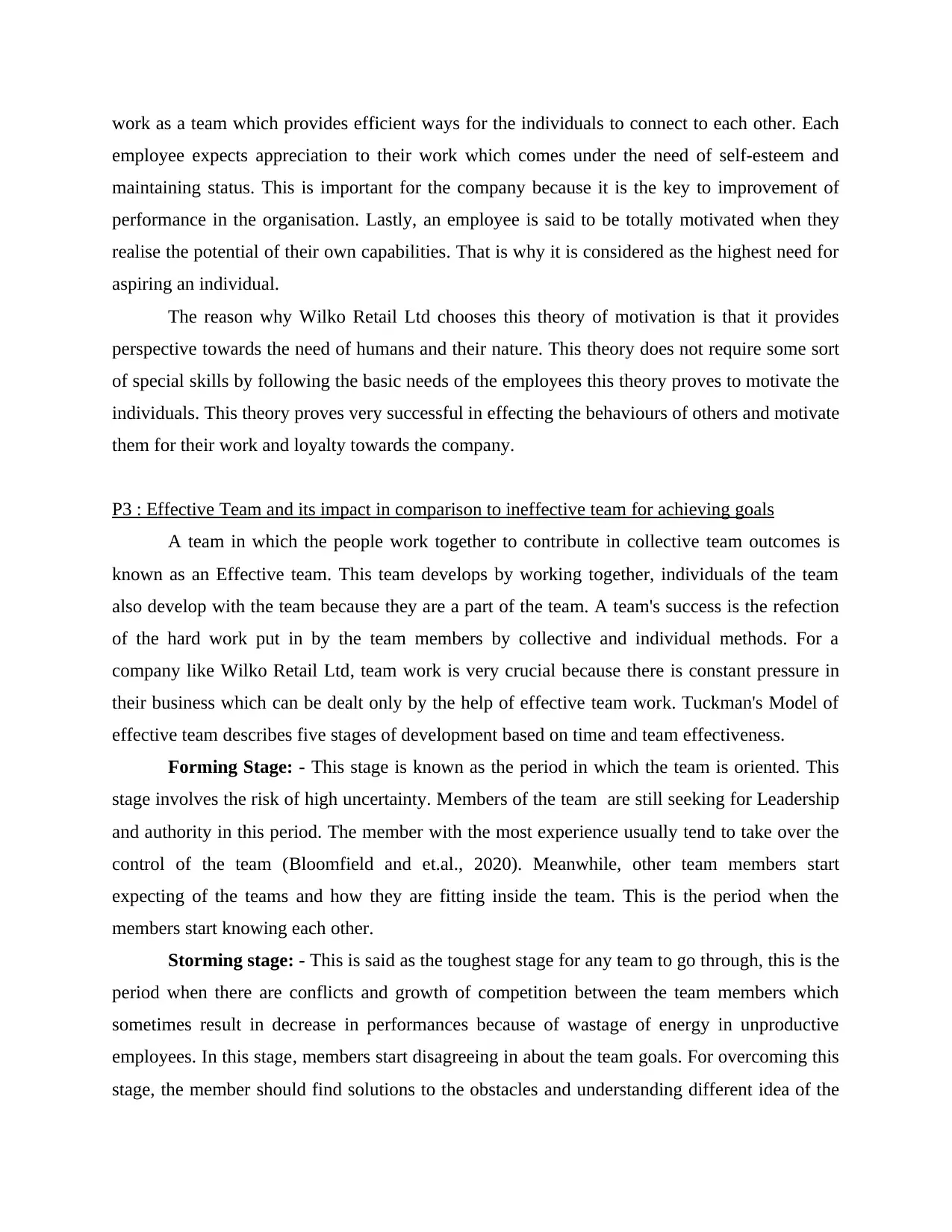
work as a team which provides efficient ways for the individuals to connect to each other. Each
employee expects appreciation to their work which comes under the need of self-esteem and
maintaining status. This is important for the company because it is the key to improvement of
performance in the organisation. Lastly, an employee is said to be totally motivated when they
realise the potential of their own capabilities. That is why it is considered as the highest need for
aspiring an individual.
The reason why Wilko Retail Ltd chooses this theory of motivation is that it provides
perspective towards the need of humans and their nature. This theory does not require some sort
of special skills by following the basic needs of the employees this theory proves to motivate the
individuals. This theory proves very successful in effecting the behaviours of others and motivate
them for their work and loyalty towards the company.
P3 : Effective Team and its impact in comparison to ineffective team for achieving goals
A team in which the people work together to contribute in collective team outcomes is
known as an Effective team. This team develops by working together, individuals of the team
also develop with the team because they are a part of the team. A team's success is the refection
of the hard work put in by the team members by collective and individual methods. For a
company like Wilko Retail Ltd, team work is very crucial because there is constant pressure in
their business which can be dealt only by the help of effective team work. Tuckman's Model of
effective team describes five stages of development based on time and team effectiveness.
Forming Stage: - This stage is known as the period in which the team is oriented. This
stage involves the risk of high uncertainty. Members of the team are still seeking for Leadership
and authority in this period. The member with the most experience usually tend to take over the
control of the team (Bloomfield and et.al., 2020). Meanwhile, other team members start
expecting of the teams and how they are fitting inside the team. This is the period when the
members start knowing each other.
Storming stage: - This is said as the toughest stage for any team to go through, this is the
period when there are conflicts and growth of competition between the team members which
sometimes result in decrease in performances because of wastage of energy in unproductive
employees. In this stage, members start disagreeing in about the team goals. For overcoming this
stage, the member should find solutions to the obstacles and understanding different idea of the
employee expects appreciation to their work which comes under the need of self-esteem and
maintaining status. This is important for the company because it is the key to improvement of
performance in the organisation. Lastly, an employee is said to be totally motivated when they
realise the potential of their own capabilities. That is why it is considered as the highest need for
aspiring an individual.
The reason why Wilko Retail Ltd chooses this theory of motivation is that it provides
perspective towards the need of humans and their nature. This theory does not require some sort
of special skills by following the basic needs of the employees this theory proves to motivate the
individuals. This theory proves very successful in effecting the behaviours of others and motivate
them for their work and loyalty towards the company.
P3 : Effective Team and its impact in comparison to ineffective team for achieving goals
A team in which the people work together to contribute in collective team outcomes is
known as an Effective team. This team develops by working together, individuals of the team
also develop with the team because they are a part of the team. A team's success is the refection
of the hard work put in by the team members by collective and individual methods. For a
company like Wilko Retail Ltd, team work is very crucial because there is constant pressure in
their business which can be dealt only by the help of effective team work. Tuckman's Model of
effective team describes five stages of development based on time and team effectiveness.
Forming Stage: - This stage is known as the period in which the team is oriented. This
stage involves the risk of high uncertainty. Members of the team are still seeking for Leadership
and authority in this period. The member with the most experience usually tend to take over the
control of the team (Bloomfield and et.al., 2020). Meanwhile, other team members start
expecting of the teams and how they are fitting inside the team. This is the period when the
members start knowing each other.
Storming stage: - This is said as the toughest stage for any team to go through, this is the
period when there are conflicts and growth of competition between the team members which
sometimes result in decrease in performances because of wastage of energy in unproductive
employees. In this stage, members start disagreeing in about the team goals. For overcoming this
stage, the member should find solutions to the obstacles and understanding different idea of the
Paraphrase This Document
Need a fresh take? Get an instant paraphrase of this document with our AI Paraphraser
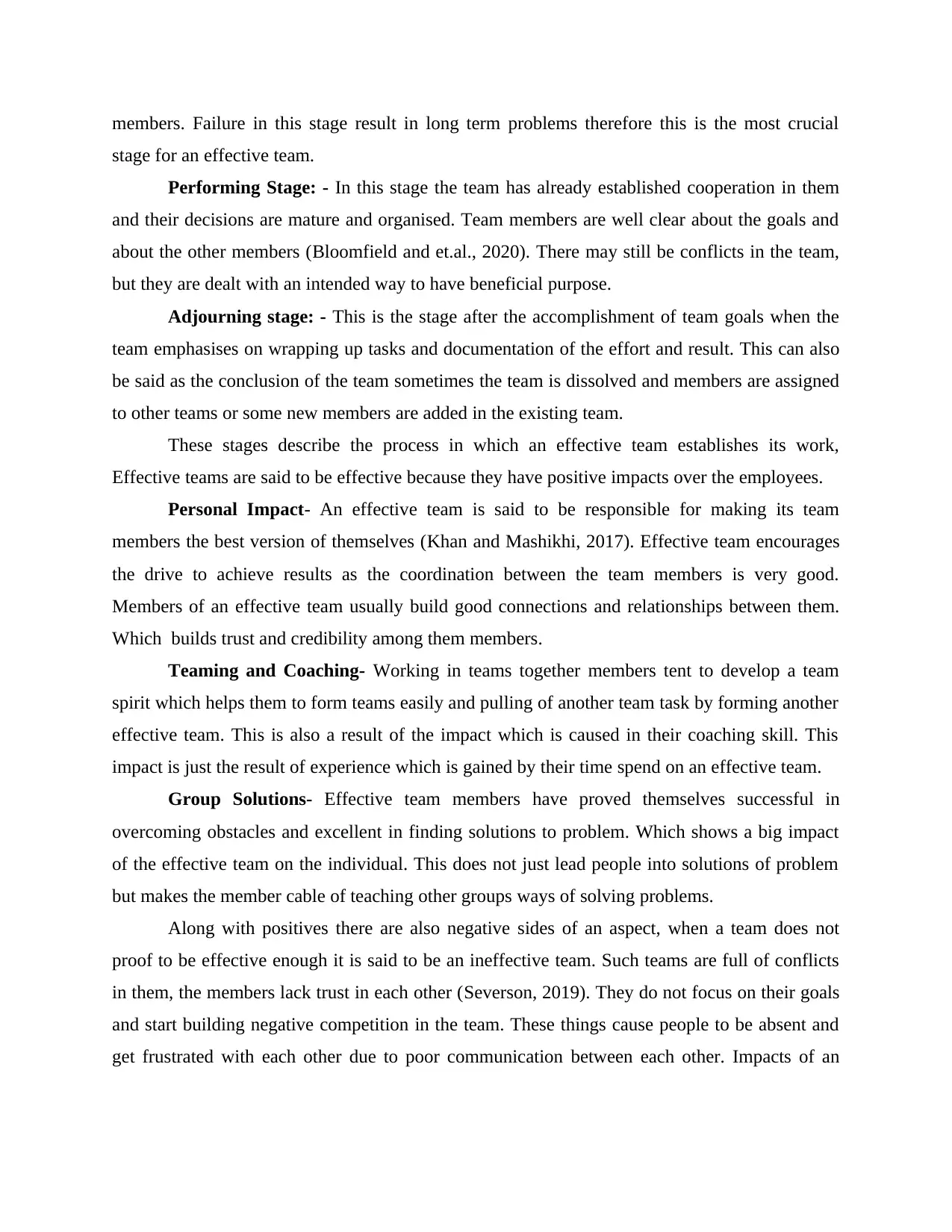
members. Failure in this stage result in long term problems therefore this is the most crucial
stage for an effective team.
Performing Stage: - In this stage the team has already established cooperation in them
and their decisions are mature and organised. Team members are well clear about the goals and
about the other members (Bloomfield and et.al., 2020). There may still be conflicts in the team,
but they are dealt with an intended way to have beneficial purpose.
Adjourning stage: - This is the stage after the accomplishment of team goals when the
team emphasises on wrapping up tasks and documentation of the effort and result. This can also
be said as the conclusion of the team sometimes the team is dissolved and members are assigned
to other teams or some new members are added in the existing team.
These stages describe the process in which an effective team establishes its work,
Effective teams are said to be effective because they have positive impacts over the employees.
Personal Impact- An effective team is said to be responsible for making its team
members the best version of themselves (Khan and Mashikhi, 2017). Effective team encourages
the drive to achieve results as the coordination between the team members is very good.
Members of an effective team usually build good connections and relationships between them.
Which builds trust and credibility among them members.
Teaming and Coaching- Working in teams together members tent to develop a team
spirit which helps them to form teams easily and pulling of another team task by forming another
effective team. This is also a result of the impact which is caused in their coaching skill. This
impact is just the result of experience which is gained by their time spend on an effective team.
Group Solutions- Effective team members have proved themselves successful in
overcoming obstacles and excellent in finding solutions to problem. Which shows a big impact
of the effective team on the individual. This does not just lead people into solutions of problem
but makes the member cable of teaching other groups ways of solving problems.
Along with positives there are also negative sides of an aspect, when a team does not
proof to be effective enough it is said to be an ineffective team. Such teams are full of conflicts
in them, the members lack trust in each other (Severson, 2019). They do not focus on their goals
and start building negative competition in the team. These things cause people to be absent and
get frustrated with each other due to poor communication between each other. Impacts of an
stage for an effective team.
Performing Stage: - In this stage the team has already established cooperation in them
and their decisions are mature and organised. Team members are well clear about the goals and
about the other members (Bloomfield and et.al., 2020). There may still be conflicts in the team,
but they are dealt with an intended way to have beneficial purpose.
Adjourning stage: - This is the stage after the accomplishment of team goals when the
team emphasises on wrapping up tasks and documentation of the effort and result. This can also
be said as the conclusion of the team sometimes the team is dissolved and members are assigned
to other teams or some new members are added in the existing team.
These stages describe the process in which an effective team establishes its work,
Effective teams are said to be effective because they have positive impacts over the employees.
Personal Impact- An effective team is said to be responsible for making its team
members the best version of themselves (Khan and Mashikhi, 2017). Effective team encourages
the drive to achieve results as the coordination between the team members is very good.
Members of an effective team usually build good connections and relationships between them.
Which builds trust and credibility among them members.
Teaming and Coaching- Working in teams together members tent to develop a team
spirit which helps them to form teams easily and pulling of another team task by forming another
effective team. This is also a result of the impact which is caused in their coaching skill. This
impact is just the result of experience which is gained by their time spend on an effective team.
Group Solutions- Effective team members have proved themselves successful in
overcoming obstacles and excellent in finding solutions to problem. Which shows a big impact
of the effective team on the individual. This does not just lead people into solutions of problem
but makes the member cable of teaching other groups ways of solving problems.
Along with positives there are also negative sides of an aspect, when a team does not
proof to be effective enough it is said to be an ineffective team. Such teams are full of conflicts
in them, the members lack trust in each other (Severson, 2019). They do not focus on their goals
and start building negative competition in the team. These things cause people to be absent and
get frustrated with each other due to poor communication between each other. Impacts of an
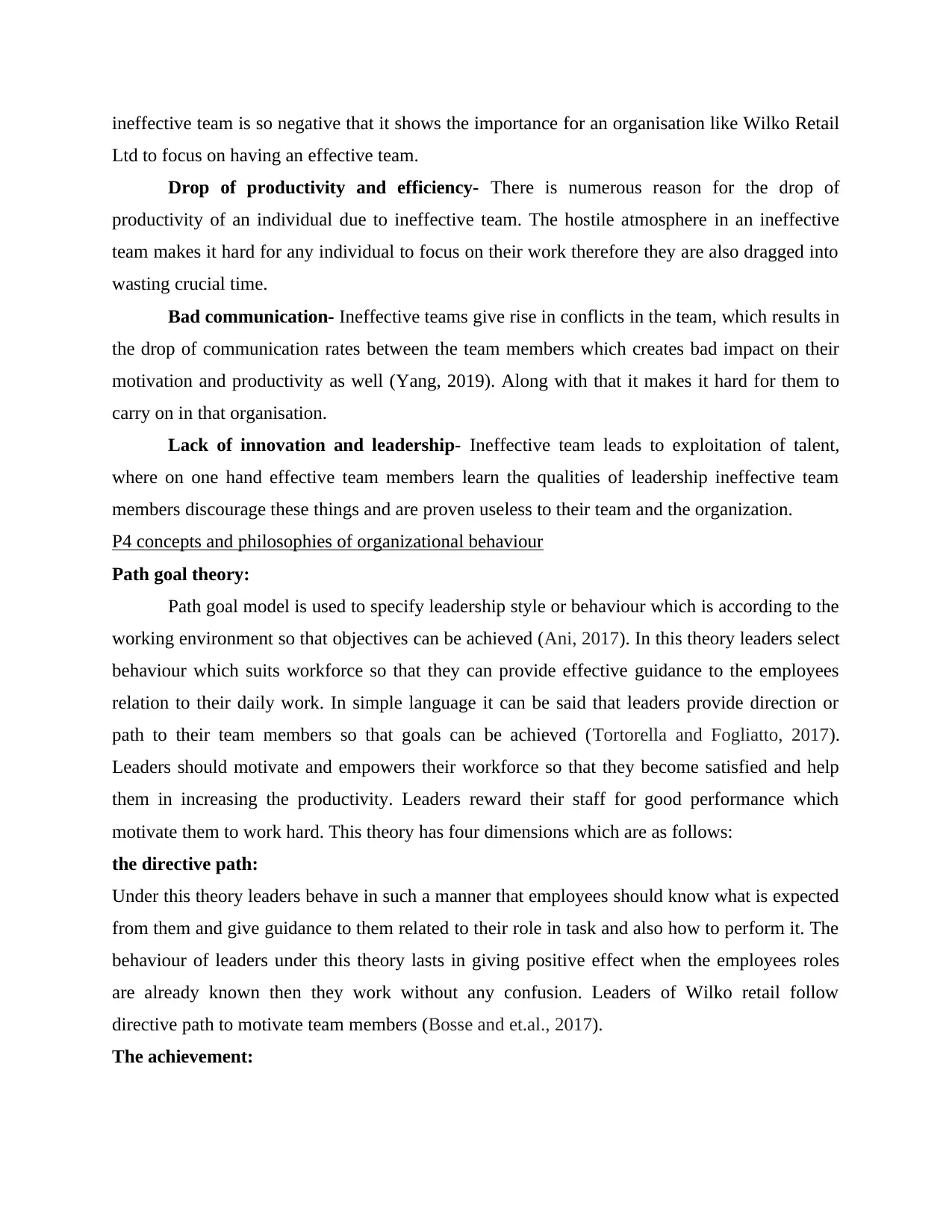
ineffective team is so negative that it shows the importance for an organisation like Wilko Retail
Ltd to focus on having an effective team.
Drop of productivity and efficiency- There is numerous reason for the drop of
productivity of an individual due to ineffective team. The hostile atmosphere in an ineffective
team makes it hard for any individual to focus on their work therefore they are also dragged into
wasting crucial time.
Bad communication- Ineffective teams give rise in conflicts in the team, which results in
the drop of communication rates between the team members which creates bad impact on their
motivation and productivity as well (Yang, 2019). Along with that it makes it hard for them to
carry on in that organisation.
Lack of innovation and leadership- Ineffective team leads to exploitation of talent,
where on one hand effective team members learn the qualities of leadership ineffective team
members discourage these things and are proven useless to their team and the organization.
P4 concepts and philosophies of organizational behaviour
Path goal theory:
Path goal model is used to specify leadership style or behaviour which is according to the
working environment so that objectives can be achieved (Ani, 2017). In this theory leaders select
behaviour which suits workforce so that they can provide effective guidance to the employees
relation to their daily work. In simple language it can be said that leaders provide direction or
path to their team members so that goals can be achieved (Tortorella and Fogliatto, 2017).
Leaders should motivate and empowers their workforce so that they become satisfied and help
them in increasing the productivity. Leaders reward their staff for good performance which
motivate them to work hard. This theory has four dimensions which are as follows:
the directive path:
Under this theory leaders behave in such a manner that employees should know what is expected
from them and give guidance to them related to their role in task and also how to perform it. The
behaviour of leaders under this theory lasts in giving positive effect when the employees roles
are already known then they work without any confusion. Leaders of Wilko retail follow
directive path to motivate team members (Bosse and et.al., 2017).
The achievement:
Ltd to focus on having an effective team.
Drop of productivity and efficiency- There is numerous reason for the drop of
productivity of an individual due to ineffective team. The hostile atmosphere in an ineffective
team makes it hard for any individual to focus on their work therefore they are also dragged into
wasting crucial time.
Bad communication- Ineffective teams give rise in conflicts in the team, which results in
the drop of communication rates between the team members which creates bad impact on their
motivation and productivity as well (Yang, 2019). Along with that it makes it hard for them to
carry on in that organisation.
Lack of innovation and leadership- Ineffective team leads to exploitation of talent,
where on one hand effective team members learn the qualities of leadership ineffective team
members discourage these things and are proven useless to their team and the organization.
P4 concepts and philosophies of organizational behaviour
Path goal theory:
Path goal model is used to specify leadership style or behaviour which is according to the
working environment so that objectives can be achieved (Ani, 2017). In this theory leaders select
behaviour which suits workforce so that they can provide effective guidance to the employees
relation to their daily work. In simple language it can be said that leaders provide direction or
path to their team members so that goals can be achieved (Tortorella and Fogliatto, 2017).
Leaders should motivate and empowers their workforce so that they become satisfied and help
them in increasing the productivity. Leaders reward their staff for good performance which
motivate them to work hard. This theory has four dimensions which are as follows:
the directive path:
Under this theory leaders behave in such a manner that employees should know what is expected
from them and give guidance to them related to their role in task and also how to perform it. The
behaviour of leaders under this theory lasts in giving positive effect when the employees roles
are already known then they work without any confusion. Leaders of Wilko retail follow
directive path to motivate team members (Bosse and et.al., 2017).
The achievement:
⊘ This is a preview!⊘
Do you want full access?
Subscribe today to unlock all pages.

Trusted by 1+ million students worldwide
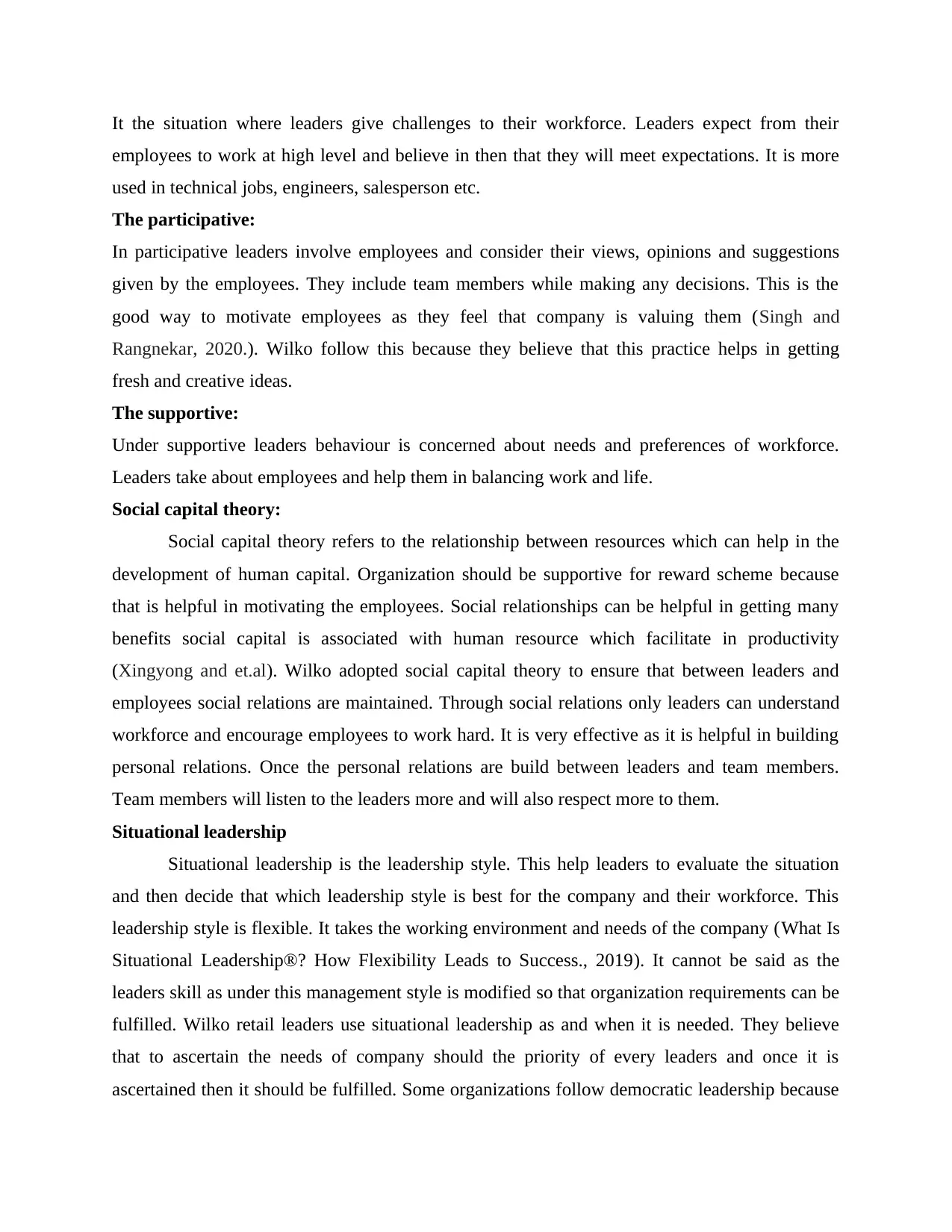
It the situation where leaders give challenges to their workforce. Leaders expect from their
employees to work at high level and believe in then that they will meet expectations. It is more
used in technical jobs, engineers, salesperson etc.
The participative:
In participative leaders involve employees and consider their views, opinions and suggestions
given by the employees. They include team members while making any decisions. This is the
good way to motivate employees as they feel that company is valuing them (Singh and
Rangnekar, 2020.). Wilko follow this because they believe that this practice helps in getting
fresh and creative ideas.
The supportive:
Under supportive leaders behaviour is concerned about needs and preferences of workforce.
Leaders take about employees and help them in balancing work and life.
Social capital theory:
Social capital theory refers to the relationship between resources which can help in the
development of human capital. Organization should be supportive for reward scheme because
that is helpful in motivating the employees. Social relationships can be helpful in getting many
benefits social capital is associated with human resource which facilitate in productivity
(Xingyong and et.al). Wilko adopted social capital theory to ensure that between leaders and
employees social relations are maintained. Through social relations only leaders can understand
workforce and encourage employees to work hard. It is very effective as it is helpful in building
personal relations. Once the personal relations are build between leaders and team members.
Team members will listen to the leaders more and will also respect more to them.
Situational leadership
Situational leadership is the leadership style. This help leaders to evaluate the situation
and then decide that which leadership style is best for the company and their workforce. This
leadership style is flexible. It takes the working environment and needs of the company (What Is
Situational Leadership®? How Flexibility Leads to Success., 2019). It cannot be said as the
leaders skill as under this management style is modified so that organization requirements can be
fulfilled. Wilko retail leaders use situational leadership as and when it is needed. They believe
that to ascertain the needs of company should the priority of every leaders and once it is
ascertained then it should be fulfilled. Some organizations follow democratic leadership because
employees to work at high level and believe in then that they will meet expectations. It is more
used in technical jobs, engineers, salesperson etc.
The participative:
In participative leaders involve employees and consider their views, opinions and suggestions
given by the employees. They include team members while making any decisions. This is the
good way to motivate employees as they feel that company is valuing them (Singh and
Rangnekar, 2020.). Wilko follow this because they believe that this practice helps in getting
fresh and creative ideas.
The supportive:
Under supportive leaders behaviour is concerned about needs and preferences of workforce.
Leaders take about employees and help them in balancing work and life.
Social capital theory:
Social capital theory refers to the relationship between resources which can help in the
development of human capital. Organization should be supportive for reward scheme because
that is helpful in motivating the employees. Social relationships can be helpful in getting many
benefits social capital is associated with human resource which facilitate in productivity
(Xingyong and et.al). Wilko adopted social capital theory to ensure that between leaders and
employees social relations are maintained. Through social relations only leaders can understand
workforce and encourage employees to work hard. It is very effective as it is helpful in building
personal relations. Once the personal relations are build between leaders and team members.
Team members will listen to the leaders more and will also respect more to them.
Situational leadership
Situational leadership is the leadership style. This help leaders to evaluate the situation
and then decide that which leadership style is best for the company and their workforce. This
leadership style is flexible. It takes the working environment and needs of the company (What Is
Situational Leadership®? How Flexibility Leads to Success., 2019). It cannot be said as the
leaders skill as under this management style is modified so that organization requirements can be
fulfilled. Wilko retail leaders use situational leadership as and when it is needed. They believe
that to ascertain the needs of company should the priority of every leaders and once it is
ascertained then it should be fulfilled. Some organizations follow democratic leadership because
Paraphrase This Document
Need a fresh take? Get an instant paraphrase of this document with our AI Paraphraser
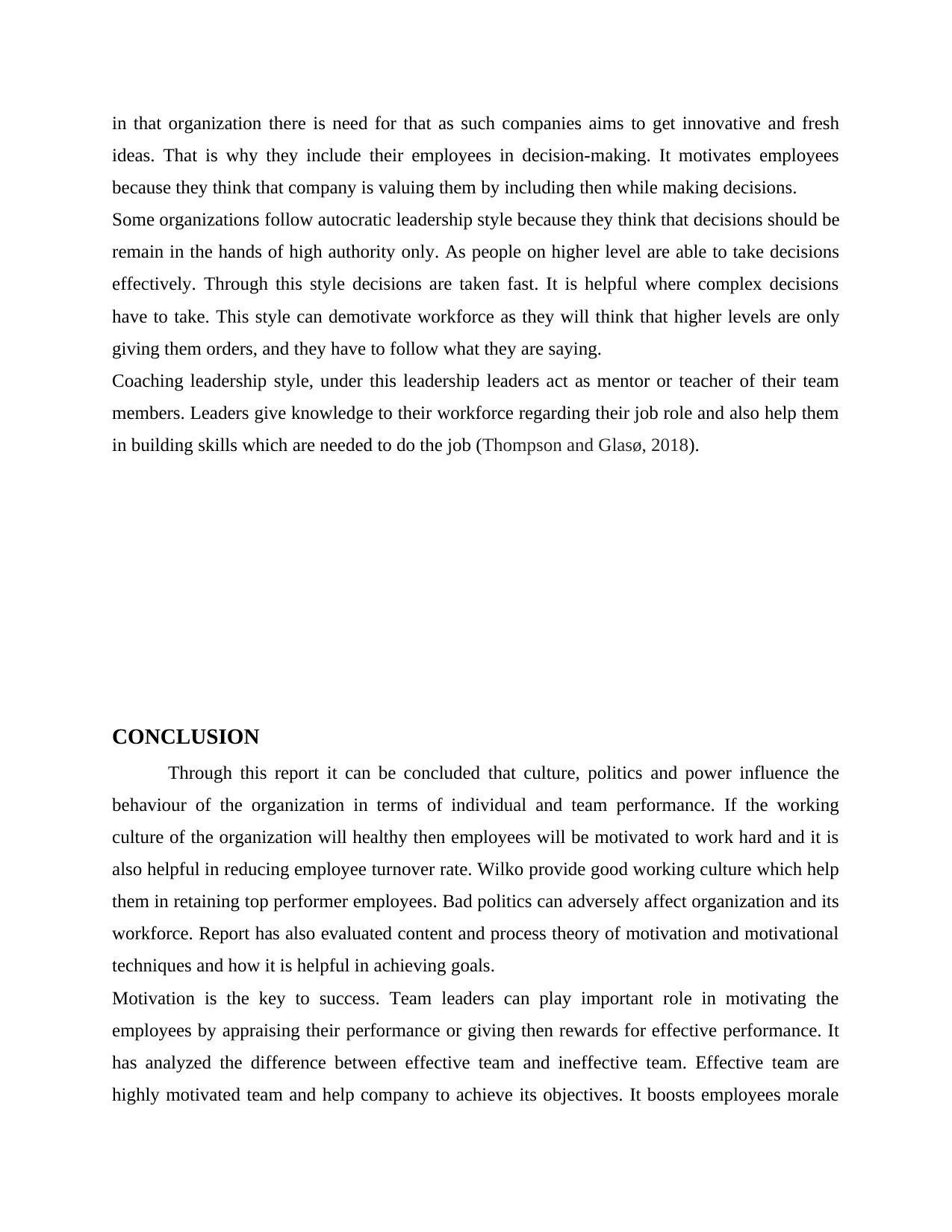
in that organization there is need for that as such companies aims to get innovative and fresh
ideas. That is why they include their employees in decision-making. It motivates employees
because they think that company is valuing them by including then while making decisions.
Some organizations follow autocratic leadership style because they think that decisions should be
remain in the hands of high authority only. As people on higher level are able to take decisions
effectively. Through this style decisions are taken fast. It is helpful where complex decisions
have to take. This style can demotivate workforce as they will think that higher levels are only
giving them orders, and they have to follow what they are saying.
Coaching leadership style, under this leadership leaders act as mentor or teacher of their team
members. Leaders give knowledge to their workforce regarding their job role and also help them
in building skills which are needed to do the job (Thompson and Glasø, 2018).
CONCLUSION
Through this report it can be concluded that culture, politics and power influence the
behaviour of the organization in terms of individual and team performance. If the working
culture of the organization will healthy then employees will be motivated to work hard and it is
also helpful in reducing employee turnover rate. Wilko provide good working culture which help
them in retaining top performer employees. Bad politics can adversely affect organization and its
workforce. Report has also evaluated content and process theory of motivation and motivational
techniques and how it is helpful in achieving goals.
Motivation is the key to success. Team leaders can play important role in motivating the
employees by appraising their performance or giving then rewards for effective performance. It
has analyzed the difference between effective team and ineffective team. Effective team are
highly motivated team and help company to achieve its objectives. It boosts employees morale
ideas. That is why they include their employees in decision-making. It motivates employees
because they think that company is valuing them by including then while making decisions.
Some organizations follow autocratic leadership style because they think that decisions should be
remain in the hands of high authority only. As people on higher level are able to take decisions
effectively. Through this style decisions are taken fast. It is helpful where complex decisions
have to take. This style can demotivate workforce as they will think that higher levels are only
giving them orders, and they have to follow what they are saying.
Coaching leadership style, under this leadership leaders act as mentor or teacher of their team
members. Leaders give knowledge to their workforce regarding their job role and also help them
in building skills which are needed to do the job (Thompson and Glasø, 2018).
CONCLUSION
Through this report it can be concluded that culture, politics and power influence the
behaviour of the organization in terms of individual and team performance. If the working
culture of the organization will healthy then employees will be motivated to work hard and it is
also helpful in reducing employee turnover rate. Wilko provide good working culture which help
them in retaining top performer employees. Bad politics can adversely affect organization and its
workforce. Report has also evaluated content and process theory of motivation and motivational
techniques and how it is helpful in achieving goals.
Motivation is the key to success. Team leaders can play important role in motivating the
employees by appraising their performance or giving then rewards for effective performance. It
has analyzed the difference between effective team and ineffective team. Effective team are
highly motivated team and help company to achieve its objectives. It boosts employees morale
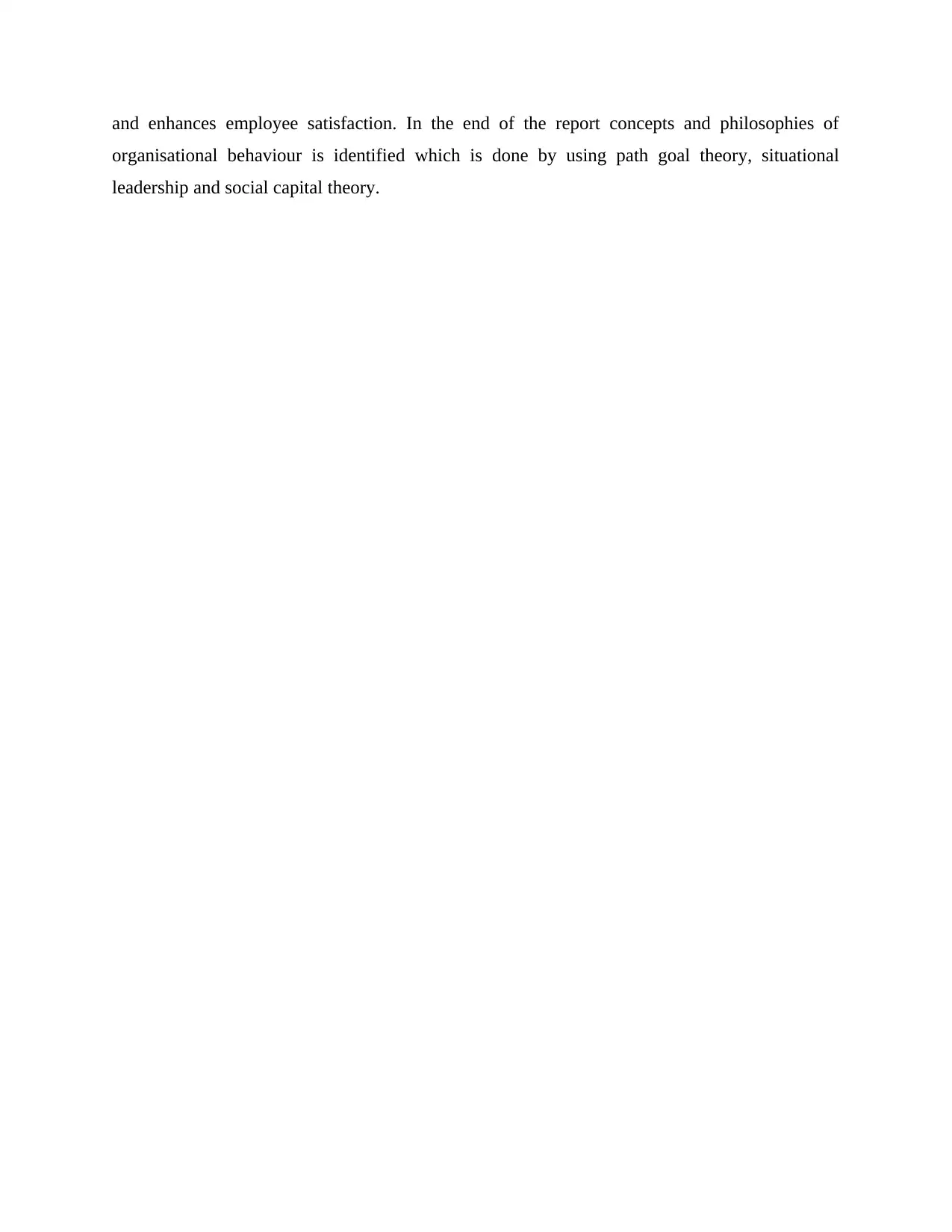
and enhances employee satisfaction. In the end of the report concepts and philosophies of
organisational behaviour is identified which is done by using path goal theory, situational
leadership and social capital theory.
organisational behaviour is identified which is done by using path goal theory, situational
leadership and social capital theory.
⊘ This is a preview!⊘
Do you want full access?
Subscribe today to unlock all pages.

Trusted by 1+ million students worldwide
1 out of 14
Related Documents
Your All-in-One AI-Powered Toolkit for Academic Success.
+13062052269
info@desklib.com
Available 24*7 on WhatsApp / Email
![[object Object]](/_next/static/media/star-bottom.7253800d.svg)
Unlock your academic potential
Copyright © 2020–2025 A2Z Services. All Rights Reserved. Developed and managed by ZUCOL.





